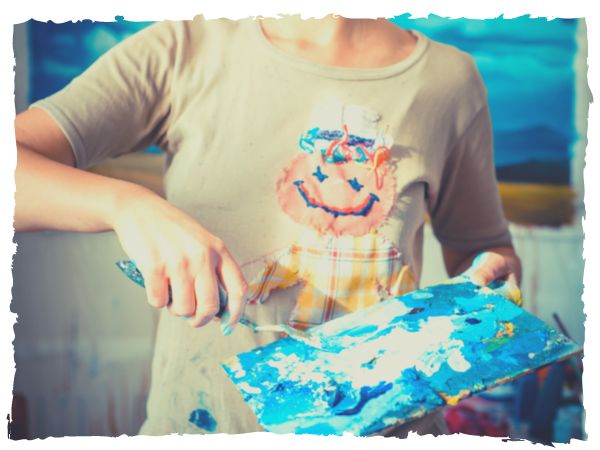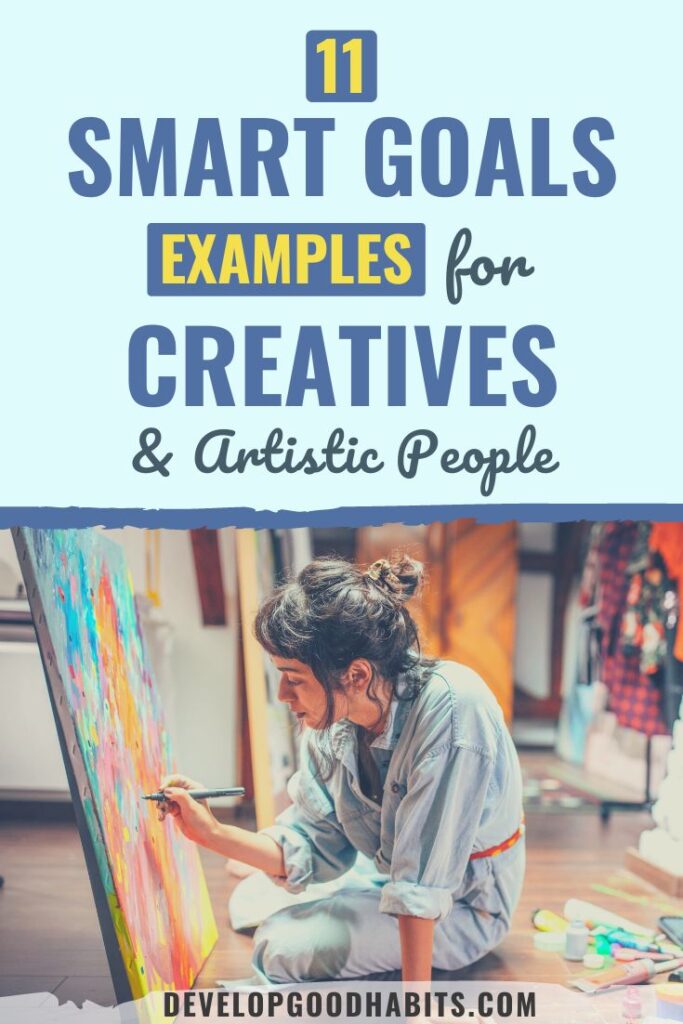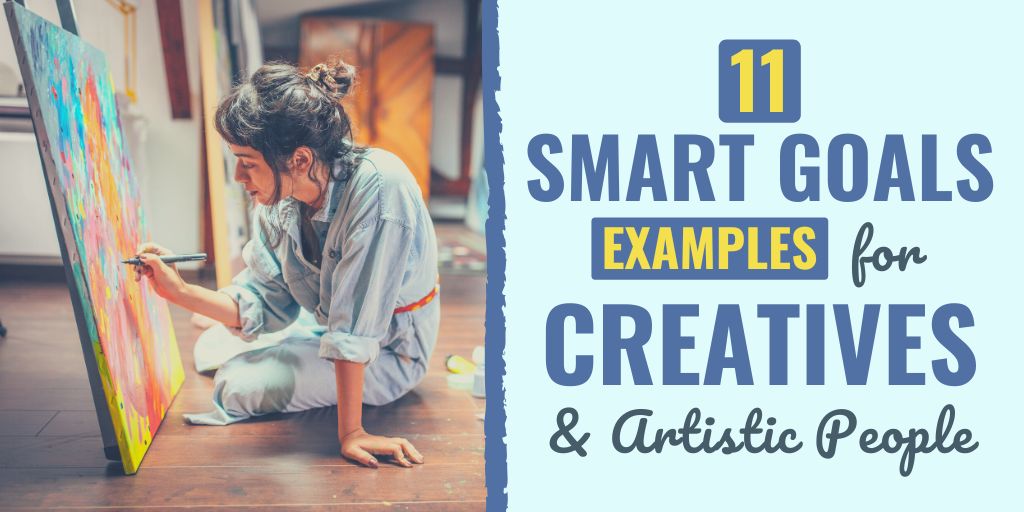There might be affiliate links on this page, which means we get a small commission of anything you buy. As an Amazon Associate we earn from qualifying purchases. Please do your own research before making any online purchase.
Being an artist or a creative person allows you a great deal of freedom in your daily life.
It’s a great way to make a living while also being able to enjoy your time and portray your skills to the world. This is however not to say that creatives and artistic people don’t face certain challenges in their day-to-day lives.
Well, to help overcome any of these obstacles, using the SMART goal-setting methodology can be very effective. Today we want to provide you with eleven examples of SMART goals for creatives and artists. By setting goals in a specific way, achieving them becomes much easier.
Today, we are first going to start by explaining what exactly SMART is and what it means. We will then discuss why such SMART goals are relevant for artists and creatives. We’re then going to finish things off by providing you with artistically related SMART goals that you can then base your own goals off of.
What Are SMART Goals?
SMART is a specific type of goal setting methodology designed to provide you with the highest chances of success when aiming to achieve any goal you might have in mind.
SMART is actually an acronym, one that stands for specific, measurable, attainable, relevant, and time-bound. Let’s take a quick look at exactly what each of these five letters mean and how they relate to your goal setting success.
To find out more about these SMART goals, take a look at this Ultimate Guide to Setting SMART Goals.
Why Are SMART Goals Important for Creatives and Artistic People?
You might be wondering why these SMART goals are so important. The reality is that being an artistic person or a creative is not easy. There are many challenges that you may face here, especially when you are just starting your career.
One of the biggest challenges right off the bat is being able to build a brand, so to speak. Being able to get the word out there and showcase your skills and talents is easier said than done.
On that note, finding clients who are willing to pay you for your work is also not easy. This is especially the case in the beginning when you have limited work to show in a portfolio. People want to see your work.
What also needs saying is that being a creative can be expensive, especially if you are into the physical art side of things. All of that artistic equipment and those tools can be quite expensive. On that note, being able to make a living from being an artist is a whole different challenge of its own.

That said, if you are really new to art, then simply learning and mastering all of the skills you need to make a living in this field is already hard enough as is. As you can see, although it can also be fun, being an artist is not easy, and there are many challenges you will face.
However, there is a good way to help make achieving all of your goals and being a successful artist much easier. Yes, here we are of course talking about SMART goals. This SMART goal system is designed in such a way to allow you to easily identify problems and then set goals to overcome those problems.
It also involves defining specific means to achieve those goals, and certain parameters for you to determine how close you are to that goal. The simple fact is that SMART goals provide you with a clear and measurable path to success that you just don’t get anywhere else.
Examples of SMART Goals for Creatives & Artistic People
1. Create and Maintain Social Media Profiles
“My goal is to create a social media profile on both Facebook and Instagram, I will post at least three new pieces of work per week (as opposed to the zero works currently being posted), I will start with one post per week and increase this by one post per week until I reach three posts per week.
My secondary goal is to get the word out there, and by posting my art, my goal is to increase the amount of followers I have by at least 50 people each week.”
S: This goal is specific, to use social media to create X amount of posts per week in order to gain X amount of followers, and eventually X amount of clients.
M: This goal is easy to measure because you can easily track how many followers and clients you have.
A: This goal is attainable because social media is a proven way to gain traction in this field.
R: This is relevant because you obviously need to get clients to make money as an artist.
T: This goal is time bound, to get a certain amount of new clients and followers in a week.
2. Use a Variety of Marketing Methods
“My goal is to use word of mouth advertising, social media, and other outreach methods to increase the amount of paid art commissions I get on a weekly basis from zero to three per week.
My goal is to get 1 commission in the first week, 2 in the second, and three in the third, and possibly more, granted I have the time to take care of so much work.”
S: This goal is specific, to use various advertising means with the aim of getting more paid commissions on a regular basis.
M: This goal is measurable simply by tracking how many new clients you get on a weekly basis.
A: This goal is attainable and realistic, as using various marketing means is a great way to get the word out there.
R: This goal is relevant in terms of finding new paying clients and making a living as an artist.
T: This goal is time-bound, as the aim is to get a certain number of new commissions on a weekly or monthly basis.
3. Learn a New Skills Every 3 Months
“My goal is to learn a new artistic skill every three months, which I will then practice until I have mastered the main tenets of each specific skill. To do this, I will take a variety of art classes focused on various topics.
I plan to take the first art class within one week and finish it in whatever allotted amount of time there is. To monitor my progress, I will keep track of the new skills I learn, and I will pay close attention to the grades or scores that I get in these art classes.”
S: This goal is specific, to take classes to learn new artistic skills.
M: This goal is measurable by keeping track of the skills that you want to learn versus those that you currently know, as well as by paying attention to the grades received in those courses.
A: This goal is very attainable and realistic, because going to school and taking classes is exactly how people learn new things.
R: This goal is relevant because the only way to improve as an artist is to learn more and keep practicing.
T: This goal is time bound, to learn the new skills and successfully complete the courses within the allotted amount of time.
4. Recreate a Photograph on Canvas
“My goal is to accurately recreate a photograph portrait of a human being as realistically as possible using canvas and oil paint. I will do one painting per day of the say photograph, at least once every three days.
Through constant practice, my end goal is to get this painted portrait looking as realistic as humanly possible within 3 months of starting this process.”
S: This goal is specific, to realistically recreate a portrait of a human being using oil paint.
M: This goal is measurable, subjectively, by comparing the original photograph to your improving works.
A: This goal is realistic, mainly seeing as there are plenty of realist artists out there who excel at doing just this.
R: This goal is relevant because being able to accurately recreate real life images does come in quite handy as an artist.
T: This goal is time bound, to effectively and accurately recreate that portrait in a 3 month timespan.
5. Save 10% of Commissions
“To ensure my financial security, my goal is to set aside at least 10% of all artistic commissions I receive into a rainy day fund, with the overall goal of saving at least $10,000 per year, or at least $800 by the end of each month.”
S: This goal is specific, to put away X amount of money per month, or X amount per year.
M: This goal is measurable simply by keeping track of your income.
A: This goal is attainable through some simple budgeting.
R: This goal is relevant because sometimes it can be hard to make money as an artist, so saving cash where you can is ideal.
T: This goal is time bound, to save a certain amount of money in a one year period.
6. Perform More Diverse Types of Art
“To allow myself to perform more diverse types of artwork, I will invest at least 5% of every commission I receive into new high-quality art supplies. My goal is to get at least two new pieces or types of artistic tools or equipment per month.”
S: This goal is specific, to buy new supplies with at least 5% of commissions earned.
M: This goal is measurable by keeping track of how many art supplies you have.
A: This goal is attainable because buying new equipment is a regular part of being an artist.
R: This goal is relevant because you need good supplies to be a good artist.
T: This goal is timebound, as the goal is to continuously buy new supplies on a regular basis.

7. Do One Free Piece of Art Every Month
“To help increase word of mouth talk about my artwork, my goal is to do at least one free piece of art for a friend or family member per month.
I will then ask these people to post my work on their social media profiles, with the aim of getting at least 50 new followers on social media, and at least one new paid commission per month due to this.”
S: This goal is specific, to do free artwork for close friends, and then ask them to post your work.
M: This goal is measurable by tracking how many free pieces of art you make, and then how many new followers or clients you get.
A: This is attainable because using word of mouth generally works quite well for this kind of thing.
R: This goal is relevant as it directly relates to finding new paying clients.
T: This goal is time bound, to get at least one new paid commission per month.
8. Study Art at College
“My goal is to enroll at an accredited art college to complete my degree in visual or fine arts. To achieve this, I will get brochures of various colleges in week one, and by week two, I will create a short list, including costs, requirements, and course details.
In the third week, I will have a budget ready to assess whether I can afford the college I choose and alternative plans if I need more funding. In week four, I will have enrolled at a college.”
S: The specifics of this goal include finding a college, choosing the best one, deciding whether you can afford it, and enrolling once you’ve got all the information.
M: It’s easy to measure this goal as you can use a simple checklist to keep track of your progress and to see what elements of the goal remain to be done.
A: You can attain this goal as there are two art colleges nearby that you can attend.
R: Getting an art degree is relevant as having a degree will improve your resume and prestige.
T: Having money saved will help prevent a delay in your enrollment for your studies (part time vs full-time studies), and it’s also important to help you budget and ensure you can finish the degree course in the time you have available.
9. Regularly Host Art Workshops
“Hosting art workshops for the art-loving public is a great way to build a name and expand my markets to include local collectors and creatives.
I will plan a workshop, book a venue, advertise the workshop via community groups on social media, host the workshop and take some photos, post these online, and build my social media presence.
If the workshop is well-attended, I will host one such workshop every month, becoming a regular feature online.”
S: Your goal is specific: hosting art workshops to ensure people know about you and you can share your skills in public. So, you can reach your goal through attendance, which you can track with a sign-in sheet.
M: Tracking your goal to host workshops is easy to monitor as you can keep a record of how many workshops you’d like to host and how many people attend.
A: Your goal is attainable, and your goal can easily be achieved by working in partnership with a local community organization that has a venue you can use for free or at discount rates. It’s one day a month out of your time, which makes it perfect to fit into your busy schedule.
R: Community involvement helps you stay relevant and also brings real people within reach of your art. The goal is also relevant to your career plans, as you can build a public name for yourself with the exposure from the workshops.
T: Your goal has a time limit on it as you’re planning on hosting these workshops every month, thereby making this a repeat goal to help you build your career.
10. Open My Own Gallery or Studio Space
“Every artist dreams of having their own art studio or gallery, and I will achieve this goal in the next three months by first creating a name for myself by getting some of my artwork in major galleries and in some private collections.
Once I have a reputation, I will look for a space to lease in the art district of New York, which I will lease for six months minimum. I will approach other emerging artists I know from art school and exhibits to submit work and populate the gallery within the first month.
Opening night will feature a keynote talk by a famous artist I know as a drawcard to get critics and collectors to attend. I will sell enough artwork to pay my costs within the first month of commissions. My gallery will succeed because of all the clever marketing I will use, such as loaning artworks for photoshoots for local glitter magazines over the first three months.”
S: This goal is specific as it states what is to be achieved: Opening a gallery. The goal also contains the specifics of how to do it, how to market the gallery, and how to keep it going.
M: With measurable steps, such as where to find the gallery space, how long to lease it, what artists to approach to feature their work at the gallery, and who to approach as keynote speaker, there is a specifically measured progression.
A: You can attain this goal as it’s made of smaller steps that build to a larger goal. First looking for the best lease space for the gallery and then signing a contract, followed by the marketing strategy, finally approaching related industries like modeling.
R: Art will always be relevant, and as an artist, creating your own studio space is a relevant move that will anchor you in the industry, while creating a network of creative contacts who can help build your dream.
T: The goal has a time limit, which makes it targeted and gives you a clear window of opportunity.
11. Travel to Italy and France
“My goal is to travel to Italy in the next six months to tour the classical galleries and chapels where the works of the great master painters can be seen. I want to create a vlog about the journey, what my experiences were, and provide an in-depth view into art restoration and how art creates culture.
To create my journey, I will save $1000 each month, look for sponsors, and apply for learnerships and apprenticeships to help me afford the costs. I will reach out to gallery owners and curators to schedule one-on-one interviews and behind-the-scenes looks that people may not normally see.
The footage taken on my tour will feature in my gallery, be sold at auctions, and continue my career trajectory.”
S: The specific goal is to travel to Italy and France on an art tour and vlog about it.
M: Progress is measured by planning the journey, saving, and booking facilities and making travel arrangements.
A: Every step of this goal can be reached, and with a step-by-step approach, you can get to see all these art destinations.
R: As an artist, this is a relevant goal, and the inclusion of a vlog makes it relevant to new technology in the market of creativity.
T: This goal is time-bound as you have six months to plan, save for, and book your trip. You also have smaller monthly goals, such as saving monthly for the trip.
Final Thoughts on Smart Goals for Creatives
The bottom line here is that while there are many challenges you will face in the art world, using SMART goals can certainly help you overcome them.
Define your problems and objectives, figure out how to achieve those objectives, and make sure to measure your progress along the way.
And if you want more SMART goal ideas and examples, be sure to check out these blog posts:
- 5 SMART Goal Examples to Improve Your Positive Mental Health
- 7 SMART Goals Examples for Time Management & Productivity
- 8 SMART Goals Examples for Improving Your Interpersonal Skills
Finally, if you want to take your goal-setting efforts to the next level, check out this FREE printable worksheet and a step-by-step process that will help you set effective SMART goals.


